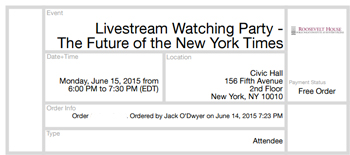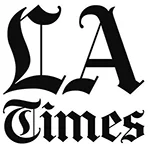The "sustainability" of the New York Times will be discussed Monday, June 15 at 6 p.m. by Publisher Arthur Sulzberger at Hunter College which is providing a live videocast of the event. Questions from the public will be allowed.
Capacity of 624 has been reached but it is being live videocast. Those who want to watch the program at a "watching party," running from 6 to 7:30 p.m., which will include a half hour of questions from the audience, can register in advance with Eventbrite.
Jack Rosenthal, interim director of Roosevelt House at Hunter, will interview Sulzberger and executive editor Dean Baquet at the Sylvia and Danny Kaye Playhouse, 695 Park ave. between 68th and 69th sts.
 Hunter's announcement of the appearance by Sulzberger and Baquet said that while NYT "remains a premier source of news and information and has won 117 Pulitzer Prizes, it is competing "in an era when online communications giants measure their revenues in many billions" and "questions inevitably arise about the sustainability of The Times, new and business questions to be discussed at this evening."
Hunter's announcement of the appearance by Sulzberger and Baquet said that while NYT "remains a premier source of news and information and has won 117 Pulitzer Prizes, it is competing "in an era when online communications giants measure their revenues in many billions" and "questions inevitably arise about the sustainability of The Times, new and business questions to be discussed at this evening."
Title of the event, as noted for the Livestream Watching Party, is "The Future of the New York Times."
NYT Revenues: $1.58 Billion
NYT, which had revenues of $1.58 billion in the latest 12 months, lost $14.3 million in Q1 partly because of a $40.3M pension charge for payments to nearly 100 employees who were offered retirement packages. Some received two years' pay, health plans, and other settlements.
Ad sales declined 5.8% in the quarter. Print ad sales fell 11.1% while digital spots gained 10.7% to $42.3M representing 28.2% of ad income. Debt is $427M. NYT stock, as high as $70 in 1997, is now $13.
The $14.3M loss compared with a $1.7M profit in the same 2014 period. Revenues slipped 1.6% to $384.2M.
Digital subscribers grew 47,000 to 957,000, said CEO Mark Thompson. He said NYT "got off to a solid start in early 2015" as it maintained digital momentum.
Questions and Issues for NYT
Whether reporters will be among those whose questions are accepted is not known.
 Sulzberger Sulzberger |
We have sent the following advice and questions to the communications department of the paper, which is headed by VP Eileen Murphy, with the request that they be passed on to Sulzberger.
1. The lavish use of color photos and artwork, while appealing to the eye, is something that NYT cannot afford. It should stop trying to be a daily newsmagazine, noticing what happened to Newsweek, US News & World Report and is happening to Time mag. Your 64-page May 2 issue had 163 color and B&W pictures, about one-third of the "news hole."
2. Start putting tinyurl-type links in print stories to previous stories, documents, and databases. NYT should have its own custom shortened link. Web stories often have 10-20 such links. Print stories are an outmoded form of journalism without such links. Heavy use of color pictures does not make up for such a lack.
Stories Need to Be Tightened
3. Write tight. Get to the point and stop sermonizing and trying to place stories "in context." Cut pages to 36 or fewer a day and two sections and reduce price to $1. Wordiness is driving readers from the paper, wrote Michael Kinsley.
4. Remember your mission. Readers want the news, investigations and explanations. We already have plenty of color pictures in our smartphones, TV and mags. Books don't have pictures. Graphics won't attract younger readers.
5. Stop using editorial space to promote one cause or another. Put views on editorial pages and give equal space to political candidates.
6. Assign a senior business writer to do an ad/PR column. Current advertising-only reporter, Sydney Ember, is a 2012 college grad. Recognize the importance of PR/communications/social media.
7. Have regular press conferences in which Sulzberger and senior editors face the public. Instruct NYT reporters to put their email addresses at the end of stories as is done by the New York Post and other media.
8. Restore the bridge and chess columns. Bridge was a daily column for many years before being cut to three times a week. Be the "thinking person's" newspaper. Dropping bridge offended seniors who looked forward to the daily puzzles bridge hands. Inexpensive syndicated bridge columns are available. The American Contract Bridge League could supply a column. The New York Post, Newsday and many other papers continue to have daily bridge columns.
9. The "pop-up" ads on the NYT and other websites are becoming a major annoyance to users. This intrusive technique needs to be curbed.
10. Stop ducking major stories like the Tylenol murders of 1982-86 and the $1 million+ battle over an eruv Jewish boundary in the Hamptons.


 Trump Media & Technology Group today reported a $58.2M net loss on $4.1M in 2023 revenues, a disclosure that drove its stock price down 22.6 percent to $47.96.
Trump Media & Technology Group today reported a $58.2M net loss on $4.1M in 2023 revenues, a disclosure that drove its stock price down 22.6 percent to $47.96. Barry Pollack, an attorney at Wall Street’s Harris St. Laurent & Wechsler, has registered Julian Assange as a client with the Justice Dept. “out of an abundance of caution.”
Barry Pollack, an attorney at Wall Street’s Harris St. Laurent & Wechsler, has registered Julian Assange as a client with the Justice Dept. “out of an abundance of caution.” Paramount Global to slash 800 jobs in what chief executive Bob Bakish calls part of an effort to “return the company to earnings growth"... Rolling Stone editor-in-chief Noah Shachtman is exiting at the end of the month due to disagreements with chief executive Gus Wenner over the direction the magazine is taking... The New York Times broke the $1 billion barrier in annual revenue from digital subscriptions in 2023... Press Forward is investing more than $500 million to strengthen local newsrooms.
Paramount Global to slash 800 jobs in what chief executive Bob Bakish calls part of an effort to “return the company to earnings growth"... Rolling Stone editor-in-chief Noah Shachtman is exiting at the end of the month due to disagreements with chief executive Gus Wenner over the direction the magazine is taking... The New York Times broke the $1 billion barrier in annual revenue from digital subscriptions in 2023... Press Forward is investing more than $500 million to strengthen local newsrooms. The majority of news articles are read within the first three days of publication, according to a recent report.
The majority of news articles are read within the first three days of publication, according to a recent report. The Los Angeles Times gives pink slips to 115 people or 20 percent of its newsroom staff... TIME is also laying off about 30 employees, which is approximately 15 percent of its editorial staff... The Baltimore Banner, which was launched by Stewart Bainum in 2022 after he failed to buy the Baltimore Sun, added 500 subscribers per day in the three days following Sinclair Broadcast Group's deal to purchase the Sun.
The Los Angeles Times gives pink slips to 115 people or 20 percent of its newsroom staff... TIME is also laying off about 30 employees, which is approximately 15 percent of its editorial staff... The Baltimore Banner, which was launched by Stewart Bainum in 2022 after he failed to buy the Baltimore Sun, added 500 subscribers per day in the three days following Sinclair Broadcast Group's deal to purchase the Sun.


 Have a comment? Send it to
Have a comment? Send it to 
No comments have been submitted for this story yet.